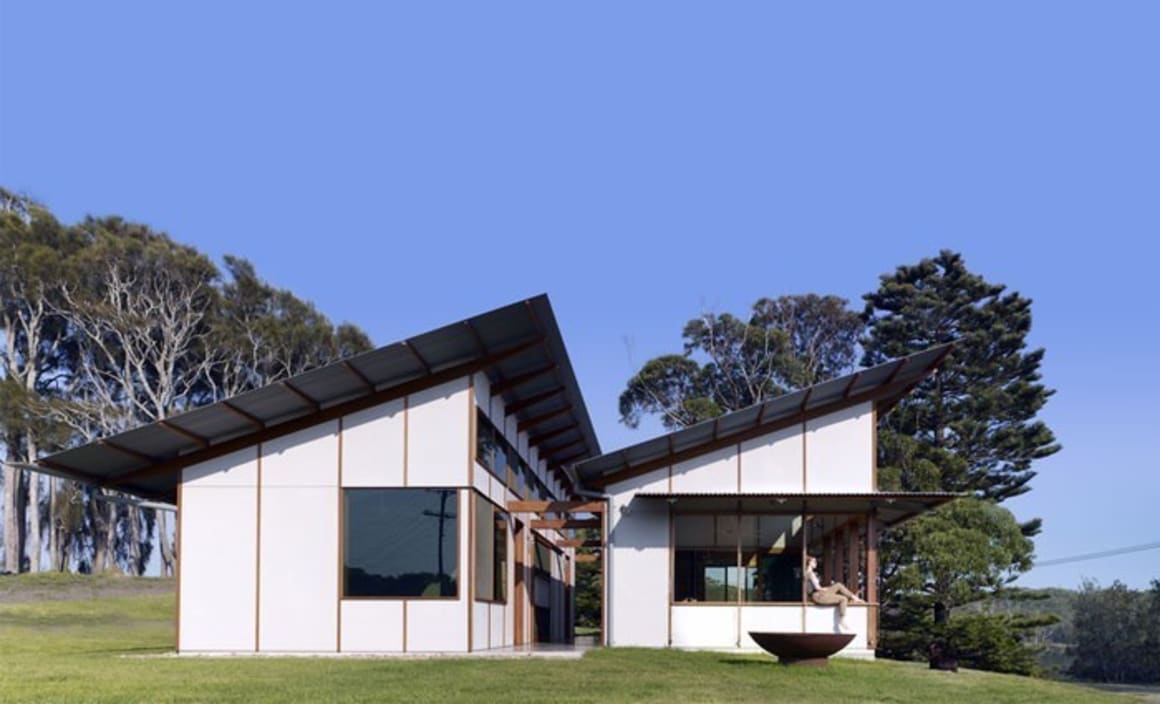Dogtrot House, camping out in Congo on NSW far south coast: He Said/She Said

The winners of the 2014 Houses Awards, organised by Architecture Media, publisher of Houses magazine, have been a hot topic of discussion for architecture aficionados - including our property contrarians, Jonathan Chancellor and Margie Blok - since the recent announcement.
Last week Jonathan and Margie reviewed Invisible House, a Peter Stutchbury designed residence which took out two awards, “2014 Australian House of the Year” and “New House over 200 square metres”.
Now in contrast to last week’s bushland location at Hampton, a harsh hamlet west of the Blue Mountains near Jenolan Caves, it is a designer shack at Congo, on the NSW South Coast, that captures their attention.
Off the beaten track and best known among surfers for its wave break called “The Suck”, Congo is located eight kilometres south of Moruya in the Eurobodalla Shire. A tiny village community with about 100 modest dwellings, Congo is about four hours drive from Sydney, and two hours drive from Canberra.
Built on a hillside outside the village, the unusual holiday house took out the award for “New House under 200 square metres”.
Known as Dogtrot House, it was designed for a family of committed campers. Their request to the architects was for a building capturing everything they loved about camping without the end of a holiday pack up. They wanted a permanent and civilised campsite.
Designed by Botany based architects, Dunn & Hillam, Dogtrot House was completed late last year. Constructed by Smith and Primmer, builders of Moruya, it is a combination of two modest pavilions (one public, one private) joined by a covered open breezeway or ‘dog trot’ corridor.
The form of Dogtrot House can be traced back to the early one room cabins that were built by farmers and fishermen. As a family grew, another cabin would be built and connected with a common roof.
During the evolution of the design for Dogtrot House, one of the architects was re-reading author Lee Harper’s To Kill a Mockingbird which made reference to the vernacular ‘dog trot’ houses of America’s south eastern states. The name comes from when the “old dog was too hot to trot” – and a covered breezeway provided the perfect escape from the heat of the day.
A dogtrot house historically consisted of two log cabins connected by a breezeway or "dog trot", all under a common roof. Typically one cabin was used for cooking and dining, while the other was used as a private living space, such as a bedroom.
Architects continue to build dogtrot houses using modern materials but maintaining the original design.
Complimenting the intrinsic Australian flavor of Dunn & Hillam’s design, the jury commented: “Although in an obvious lineage of Australian shed architecture, this simple shelter is convincingly a permanent camp site, where the experience and delight of being in the place are more important (and rejuvenating) than conventional comforts. Yes, you will occasionally get wet and cold, but genuine immersion in a special place has clearly underpinned the development of this scheme”.
“Careful consideration of the plan reveals that the major room at the north is essentially a covered outdoor room – the caravan annexe or tent fly. It is the space for community, from which daily activities are planned, launched and celebrated. Truly interior spaces are the all-weather places that permanent camp sites require – for sleeping, ablutions and cooking.”
“Considerable effort has been made throughout this house in plan, section and materiality, all of which contribute to the sense of care and privilege. Although base camps can be made in multiple (and often destructive) ways, Dogtrot House is rendered in an articulate and rigorous manner by architect and builder while never presuming that buildings are more significant than landscape.”
HE SAID:
I love the roofline, but am left a little underwhelmed by its modest exterior.
It makes up inside with its unexpectedly high quality, comfortable and practical interior.
As a fan of the South Coast, I appreciate, of course, it simply doesn't need to have all the North Coast Boomerang Beach pretensions.
And nor is it typically suburban, as Margie points out below. So it's a thumbs up from me.
 SHE SAID:
SHE SAID:
Dogtrot House is perfect for someone like me who loves unwinding at old-style coastal holiday shacks with a few creature comforts. And it is perfect for someone like Jonathan who was born in a tent.
I love its simplicity and also its direct connection with the great outdoors. This uncomplicated holiday shack style is much more prevalent in the bachs of New Zealand than the NSW coastline where enormous designer holiday houses and hideously suburban homes have mushroomed during the past two decades.
I think it would be a joy to spend time at Dogtrot House with family and friends - cooking up a storm in the kitchen with its tranquil lagoon views; chilling out in the Japanese bath; and reading and relaxing in the big indoor/outdoor room with its built-in banquette seating.
I’m all for getting back to the simple life, so Dogtrot House gets the thumbs up from me.
Photos courtesy of Dunn & Hillam Architects.